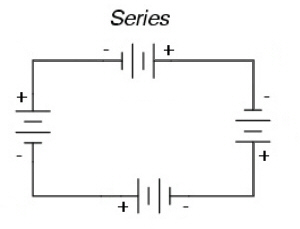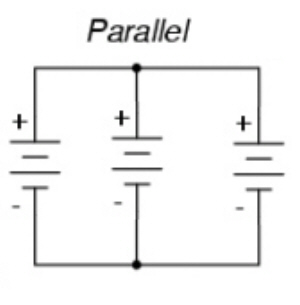.: series & parallel circuits

|
With batteries in series the
voltage of the batteries are
added, but the Amp hour rating
(Ah) is not combined. The
voltages can be different, but
the Ah should be the same,
otherwise
the lowest Ah battery will
reduce the Ah rating of the
entire pack. |

|
When batteries are connected in
parallel the voltage of the pack
does not change, but the Ah
rating of each battery are added.
Each battery should have the
same voltage. The Ah can be
different, but doing so will
stress the lowest Ah battery and
reduce its life. |
.: power (watts)
Watts = volts *
amps
|
.: current capacity for copper
The current
capacity of a conductor is limited by
the amount of heat it can withstand. The
general rule of thumb for a copper
conductor with continuous
DC current, is 1000 amps
per square inch. AC current does not
generate as much heat so its generally
accepted guidelines are 1300 amps per
square inch.
.: diodes
Diodes are one-way
valves. They allow current to flow in
one direction, but not the other.
.: fuses
Fuses
limit the current flowing in a circuit.
For low voltage devices (below 50
volts), the voltage rating of a fuse is
not an issue. However, when voltages
higher than a fuses rating blows, a
spark may jump between the contacts
which allows current to flow in the
circuit.
.: fusing a dc-dc converter
A typical electric vehicle's 400 watt
dc-dc converter will supply 30 amps at
12.5 volts (30 amps * 12.5 volts = 375
watts). The output should be fused at 30
amps, but if its input is 150 volts, the
input fuse only needs to be
3 amps, NOT 30amps! This is
because the converter has 400 watts
input:
- 400 watts
/ 150 volts = 2.667 amps
.: resistors
Resistors are called a
passive device because it there is no
method to control its behavior. It
reduces the current and voltage (power)
to the circuit downstream. In exchange
for this reduction in power, it give off
heat.
.: transformers (dc-dc
converter)
There are a
multitude of transformers. Transformers
do not increase the power, they change
it by either increasing the available
voltage and decreasing the available
amperage (like an ignition coil), or
decreasing the available voltage and
increasing the available amperage (like
electrical grid transformers).
For
electric vehicles, most transformers
step-down the voltage to supply the
typical 12 volt devices. A dc-dc
converter is rated in watts (volts *
amps). Due to inefficiencies, more watts
go into a converter than come out.
|

